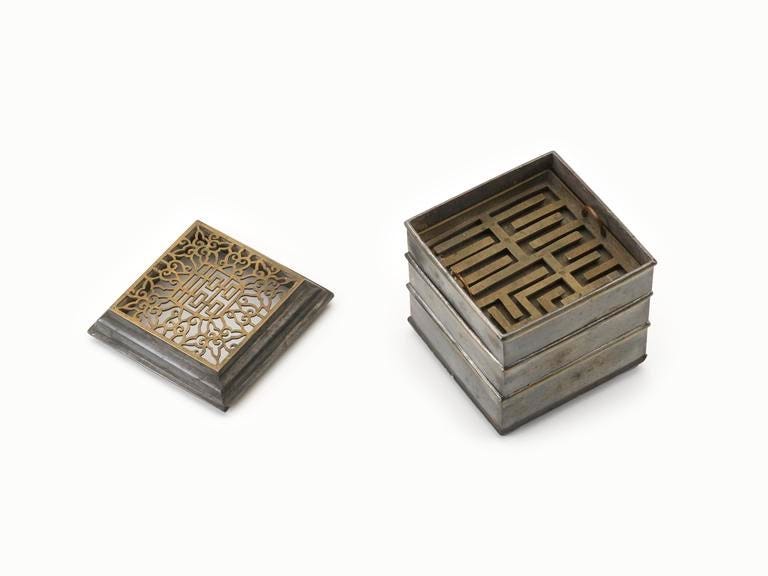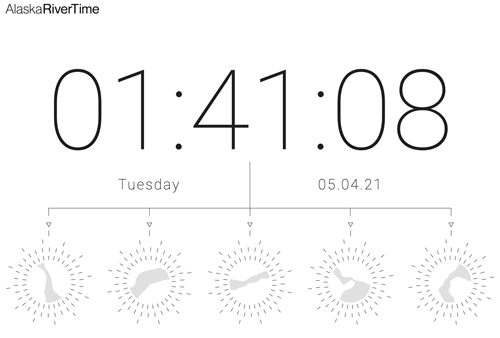How do you measure a year? As straightforward as this seems, it is a truly personal question to each of us. What comes to mind? Life, weather or seismic events, loss or gains, political enterprises, a global pandemic? Or terms such as calendars, months, or dates? As a horologist, someone who studies time, I’ve realized there is no concrete way to answer that question. Yet, my job lies in the calculation, measurement, and the sure prediction of time passing in hours, minutes, and seconds. One might say I measure time through numbers, but often it is measured through the inevitable deterioration of the mechanisms I study that are responsible for calculating the passing of time. If anything, I have found that time is not measurable, but perceptible. It is the observation of change and loss that accounts for the passing of time.

In my work I watch the brass and steel components of clock and watch mechanisms wear and break down, an indicator of how hard time has been on them. The tarnish of brass, the result of age and environmental factors. These mechanisms are continually renewed with the intention of the timepiece maintaining both its tangible and intangible qualities: its ability to calculate and record the passing of time, as well as fulfill its function as an artifact created by someone long ago with their own artistic vision and intentions for the observer. As time went on, these mechanisms were made with more wear resistant materials, always with the hope that they could outlast degradation, despite time. Perhaps one of the most successful at this was the 18th century clockmaker John Harrison, the man responsible for inventing the first marine chronometer. Some of his time pieces required no lubrication, as he invented rolling bearings for the application and relied on the synthesis between materials to maintain the time keeping qualities of the mechanism.¹ The clocks of John Harrison can still be seen keeping time at the Royal Observatory in Greenwich, London.

Keeping time is the work carried on by many before me and is one of the only things we still have in common with pre-Homo sapiens. We have measured time by seasons, famine, light, and darkness, our almanacs a result of such tidings.² These tomes published yearly include such things as tide tables, dates of eclipses and the movements of celestial bodies, and religious festivities. They recommend planting times for crops, give weather forecasts, and record the rising and setting of the sun and moon.³ Yet, none of these things truly indicate the inevitable passing of time. Only one thing changes on a molecular level from second to second. From the moment before and after a baby is born, or the instant when your loved one is still taking in breath to the moment when they are gone — the moment when you are present tense to the moment when you are past. A loss of heat is the only thing that indicates the passing of time.⁴ The more I have studied time, the more ethereal it becomes. Manifesting as water, in its different forms. Much like a snowflake melts, the longer you hold it or try to study it.⁵ Much like a snowflake, each person’s experience of time is different. It cannot be regulated. Time is a personal manifestation of our perception of the space we occupy, truly unique to each of us. It is a strange fact that our heads age faster than our feet. A shorter person is younger than you if you were born at the same instant in time.⁶ Even if time could be measured by some concrete means, our experience of time changes throughout our lives due to physical changes that occur in our brain.⁷ We cannot hold time, possess it, buy it, earn it, or commodify it. It may be the one thing we cannot commodify. Our experience of time changes, one day based on what we have gained and another through what we have lost, or more concisely put, what has changed.

Perhaps one of the oldest methods of telling time through a loss or change principle are candle clocks. The earliest ones were often long thin candles with marked intervals to indicate the passing of hours as the candle burned down.⁸ Later variations included dials and even automata.⁹ The chemistry of a candle simply explained is as follows: you light a candle, the heat from the flame melts the wax, which becomes liquid. This liquid is then drawn up into the wick via capillary action. The heat from the flame vaporizes the liquid wax turning it to gas, which is then drawn into the flame creating heat and light. Enough heat is created to continue this cycle until the wax is exhausted.¹⁰

Incense clocks work in a similar fashion and at times were just as elaborate with bells and gongs, pulleys, and dials. The simplest form was that of an incense stick calibrated to burn at a known rate of combustion. Hours, minutes, and days were passed in witness of the incense stick.¹¹ Yet these forms of telling time through loss are based on confined, predictable, known systems. Our time is not. Our bodies are not like candles or incense sticks and yet we deteriorate with time, changed by factors such as our environment, toxins, or disease that can accelerate the deterioration of our bodies. Change is the body’s way of knowing time.
This may not leave one feeling very grounded in their experience of time, yet our individual perception is all that we have. Life by nature is fleeting. It does not outlast time. Our life is finite and time continues. It is one of the great condolences it can offer. When loss is too great to bear, remember the age-old adage, “everything passes with time.” There is wisdom with this idea carried across cultures. In the Cheyenne Native American tribe, there was a saying told to those ailing, going into battle, or suffering the losses that life brings,
My friends,
Only the stones
Stay on Earth forever
Use your best ability¹²
Though stones change, they do stay. They lose their original primeval form, eventually becoming something only recognizable through magnification. Their erosion is an indicator of time, much like seasons. The degradation of all materials, organic and inorganic, is irreversible and inevitable. To calculate the passing of time through the lens of water eroding stone is a manifestation of nature’s experience of time. Time is based here on the flow rate of the river. It is season based, environment based, climate based, degradation based and is impacted both negatively and positively through the cumulative actions of human beings.

The Alaska River Time project of Jonathon Keats brings about an intentional unification between nature’s experience of time and our perception of its passing, while bringing to light our direct impact on it. We are both forced to bear witness and invited to engage. It is not unlike the time realized in our bodies, but here through known bodies of water.
I’d like to say that River Time can offer a more accurate time keeping system than the finest atomic clock, quartz watch, or mechanical time keeper, as it provides a true reflection of time through real time change. I realize that it is unpredictable and the flow rate of a river depends on many factors that the river is forced to exist within, that it cannot control, but can only experience. Perhaps it is this unpredictability which is its greatest asset.
Notes
[1] Jonathan Betts, John Harrison: inventor of the precision timekeeper.
[2] “The term almanac is of uncertain medieval Arabic origin; in modern Arabic, al-manākh is the word for climate,” From the Encyclopaedia Britannica.
[3] Encyclopaedia Britannica.
[4] Carlo Rovelli, The Order of Time.
[5] Carlo Rovelli, The Order of Time.
[6] Carlo Rovelli, The Order of Time.
[7] David Eagleman, Livewired: The Inside Story of the Ever-Changing Brain.
[8] H.H. Cunynghame, Time and Clocks: A Description of Ancient and Modern Methods of Measuring Time.
[9] Alfred Chapuis, Le Monde des Automates.
[10] Encyclopaedia Britannica.
[11] N.H.N Mody, Japanese Clocks.
[12] Paul Goble, The Boy and His Mud Horses: and Other Stories from the Tipi.
Bibliography
Alfred Chapuis and Eduouard Gelis, Le Monde des Automates: Etude Historique et Technique (Paris: 1928), Pages 51–68.
Britannica, T. Editors of Encyclopaedia. “Almanac.” Encyclopedia Britannica, January 25, 2018. https://www.britannica.com/topic/almanac.
Britannica, T. Editors of Encyclopaedia. “Candle.” Encyclopedia Britannica, July 20, 2019. https://www.britannica.com/technology/candle.
Carlo Rovelli, The Order of Time (New York: Riverhead Books, 2018), Pages 3, 10, 25.
David Eagleman, Livewired: The Inside Story of the Ever-Changing Brain (New York: Pantheon, 2020).
H.H. Cunynghame, Time and Clocks: A Description of Ancient and Modern Methods of Measuring Time (Detroit: Single Tree Press, 1970), Page 46.
Jonathan Betts, John Harrison: inventor of the precision timekeeper. Endeavour Volume 17, Issue 4, 1993, Pages 160–167.
N.H.N Mody, Japanese Clocks (Japan: Charles E. Tuttle Company, Inc., 1977), Plate 114.
Paul Goble, The Boy and His Mud Horses: and Other Stories from the Tipi (China, World Wisdom, Inc., 2010).
Recommended Reading
- Desert Solitaire by Edward Abbey
- The Order of Time by Carlo Rovelli
- The Sound of a Wild Snail Eating by Elisabeth Tova Bailey
Learn More
- Watch Brittany Cox’s 02019 Interval talk, “Horological Heritage.”
- Watch Jonathon Keats’s 02015 Interval talk, “Envisioning Deep Time.”
- Pre-order Jonathon Keats’s forthcoming book, Thought Experiments: The Art of Jonathon Keats.
This essay was commissioned by the Anchorage Museum and was originally published on the Alaska River Time website.